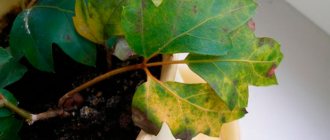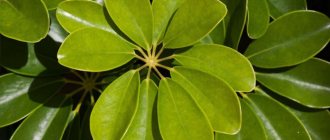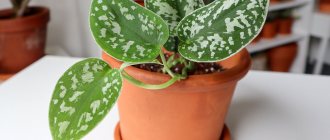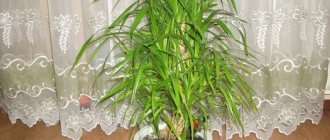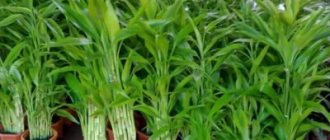Description of the plant
Cissus is a member of the Grape family, or Vitaceae, which includes more than three hundred plants, including those common in tropical and subtropical zones. A significant part of cissus are climbing vines, which, like ordinary grapes, cling to support through tendrils. Cissus foliage can be either whole or dissected.
In indoor floriculture, cissus blooms extremely rarely. Small and unassuming flowers on cissuses are collected into a kind of false umbrellas. Cissus is valued by gardeners as an easy-to-care, decorative foliage hanging plant, which is ideal for growing in hanging pots.
Signs and superstitions
Indoor flowers have lived in people's homes for many centuries. It is not surprising that signs and superstitions associated with various plants arose. Cissus is no exception.
It is believed that this flower drives men out of the house. In other words, he is to blame for the fact that men do not live in the house or leave the house, or the owner of the plant is lonely. There is also a superstition that cissus brings misfortune to the house.
It is difficult to judge how true these superstitions are. After all, there is another opinion that all fresh flowers that grow and develop well in the house bring positive energy into it, and simply make the housewife happy, thereby creating this very positive energy.
Popular varieties of cissus
In indoor floriculture, the most widespread are Antarctic Cissus, or Cissus antarctica, as well as Rhombifolia Cissus, or Cissus rhombifolia, which are distinguished by their shade tolerance and unpretentiousness.
Antarctic cissus (Cissus antarctica)
C. antarctica is a highly climbing plant. This cissus easily clings to supports with the help of its antennae. Antarctica has brownish stems, bright green leaves, up to 8 cm in size, oval and rough to the touch. The stems, petioles and tendrils are characterized by dense pubescence. The flowers are greenish in color and are collected in corymbose inflorescences.
The plant is characterized by active growth and unpretentiousness. Looks great in hanging pots and baskets.
Rhomboid cissus, or rhombifolia (Cissus rhombifolia)
C. rhombifolia belongs to the category of herbaceous vines and is the most unpretentious species in indoor floriculture. It has diamond-shaped, trifoliate and compound leaves of a dark green color, with serrated edges. The plant has pubescent stems and petioles, as well as small tendrils.
Under conditions of natural growth, C. rhombifolia blooms with very small, greenish-colored flowers, which are collected in a racemose type of inflorescences with the formation of edible red fruits.
Cissus discolor
C. discolor is the most decorative and attractive cissus in indoor floriculture. The foliage of this plant resembles living patterns, and the reddish background of the upper part of the leaves is complemented by silvery spots. The leaves have a purple color on the underside.
Under natural conditions, the plant grows in the tropics with a temperature of about 30°C and a high level of air humidity, which somewhat complicates the process of growing C. discolor at home.
Cissus striata
C. striata is characterized by the presence of very small three or five palmate leaves, which in their shape are very reminiscent of girlish grapes. The plant grows quite quickly and is absolutely not demanding in terms of air humidity. In winter, C. striata quite easily tolerates temperatures down to 30°C, which facilitates a stable transition of the plant into the resting phase.
C. striata is very convenient for indoor floriculture, but is extremely rare.
Cissus quadrangularis
C. quadrangularis is an evergreen type of vine. Such succulents can be successfully grown in indoor floriculture. The plant has fairly thick, tetrahedral shoots that are about 1 cm in diameter.
C. quadrangularis is a traditional medicinal plant used in the treatment of joints and bone tissue. The plant helps cleanse the blood and can improve its composition. Quite often used for weight loss and increasing overall tone.
In addition, in indoor floriculture, you can often find varieties of cissus such as:
- Cactus (Cissus cactiformis) ,
- Cissus rotundifolia,
- Cissus adenopoda (Cissus adenopoda),
- Amazonian cissus (Cissus amasonica).
Types and varieties of areca
Below we will describe those types of areca that are most popular among gardeners.
Three-stamen areca (Areca triandra)
The species is native to the Indian Malacca Peninsula. The height of the palm tree is about 300 cm, it has several trunks, each of which reaches no more than 50 mm in diameter. The surface of the trunk is covered with ring-shaped scars. The length of the straight pinnate leaf plates is about one and a half meters; they consist of leaves whose width is no more than 35 mm and length - from 0.5 to 0.9 m. The fragrant flowers are painted white. The length of the fruit is about 25 mm. This very spectacular palm tree is cultivated in warm rooms.
Areca catechu, or betel palm
This single-stemmed palm is native to the Malacca Peninsula and the Malay Archipelago, which are located in Eastern India. The height of the trunk, covered with ring-shaped scars, is about 25 meters, while its diameter reaches only 5–12 centimeters. The pinnate leaf plates are arched and curved and are about 1.8 meters long. They consist of densely spaced leaves, about 3 centimeters wide and 45 centimeters long. Inflorescences are formed in the leaf axils, having a length of about 0.6 m, they contain white fragrant flowers. Yellowish-red seeds are formed inside the fruit.
Reproduction and planting rules
As a rule, cissus is propagated in spring or early summer, with the appearance of new, young shoots on the plant. These plants are quite easy to propagate. It is enough to follow the following technology:
- cut cuttings from lateral new shoots, 20 cm long. Each cutting should have a small fragment of the main shoot;
- remove all the lower leaves from the cut cuttings, and then lower their end part into the composition with a mixture of growth hormones;
- fill the flower pot with a nutritious soil mixture for indoor plants and plant several, but not more than five, prepared cuttings there at once;
- cover the flower pot with cuttings with plastic film to create the effect of a miniature indoor greenhouse, and place it in a warm and bright place.
If new, young shoots appear on the cuttings, then rooting was successful and you can remove the film coating from the flower pots. Further care consists of fairly economical watering when the soil dries to a depth of one centimeter.
Well-rooted cuttings should be planted one at a time in flower pots filled with compost soil. A good effect is achieved by pinching the apical part of the shoots, which will allow the plant to branch. In spring, cissus trees should be pruned.
Questions and answers
- How to properly grow cissus in pots?
If the plant is grown as a hanging plant, the length of the branches should not exceed 50 cm so that the bush is compact and lush. Long shoots are pruned annually by 1/3. Additional shaping of the bush is carried out so that it is lush and beautiful.
- Cissus grows poorly, turns yellow, and its leaves fall off?
The flower is negatively affected by cold drafts and sudden temperature changes. It is necessary to create more favorable conditions for the plant.
- Are the leaves getting smaller and the tips drying out?
This indicates a lack of air humidity. The plant must be constantly sprayed.
5/5 — (1 vote)
Caring for indoor grapes
Despite the fact that almost all types of cissus are unpretentious plants and can be recommended for indoor cultivation even by novice gardeners, in order to maintain the healthy appearance of Cissus, cultivation technology should be followed.
Choosing a place in the room
It is necessary to place cissus plants in rooms that are oriented east and west. Liana-like plants can grow well on the north side, in artificial light conditions. When placed on southern windows, indoor grapes require shading from direct sunlight.
The most light-loving is C. rhombifolia, which is recommended to be grown near sunny windows.
Watering rules
Species that have a fairly large mass of foliage, which requires significant evaporation of moisture, primarily need abundant watering. In spring and summer, cissus plants should be watered as abundantly and often as possible. The water should be used soft and warm. It is recommended to settle tap water before watering.
In cold seasons, the amount of irrigation is reduced, and watering is carried out solely to support the life support of the plant’s root system.
Temperature and humidity
Temperatures when growing rhombifolia or Antarctic cissus should be moderate. During the cold season, temperatures can vary from 15 to 18 degrees Celsius.
For cissus multicolored, it is necessary to increase the air humidity parameters and maintain the temperature at a level of 16 to 20 degrees. Cissus are very responsive to summer spraying and weekly warm showers.
Top dressing
Fertilizing has a beneficial effect on the growth and development of cissus. Fertilizers should be applied during the active growth stage. Feeding is carried out from spring to autumn. For this purpose, it is recommended to use standard, complex fertilizers intended for feeding indoor plants. Depending on the condition of the cissus, fertilizing should be done once or twice a week.
Transfer
For young cissus, it is recommended to replant annually, which will activate the growth of the plant and significantly increase the volume of green mass. Adult cissus trees can be replanted no more than once every three years.
The size of the flower pot when replanting should be selected based on the volume of the plant’s root system. It is best to replant the plant in early spring.
How to plant cissus?
Planting cissus is not difficult. If you choose the right pot and soil, there will be no problems.
Pot
It is better to immediately plant the cuttings in separate containers, covering them with a glass jar. This way they will quickly take root.
Cissus is a vine that is grown as an hanging plant, so hanging pots are often chosen for it. The material can be any, ceramics being the priority.
For adult plants, the pot needs to be selected a little larger than the previous one so that the root system can develop further. There should be a distance of 1.5 cm between the earthen lump and the walls of the pot. The height and diameter of the pot should be approximately equal to each other.
Soil and drainage
Cissus requires soil with neutral or low acidity. It may include leaf soil, turf soil, peat, humus and sand. All ingredients must be mixed in equal proportions. In addition, the plant grows well in a universal substrate, as well as in a special soil for vines.
At the bottom of the pot it is necessary to make a drainage layer, for example, from expanded clay.
Place
The correct choice of location depends on the type of cissus. For example, the Antarctic species prefers shade. The main condition for any plant is to avoid the burning rays of the sun and observe the daylight hours. Also, you should not place the vine near heating appliances or on windows where there is a draft in winter.
The best location is on a southwest window or in the back of a well-lit room.
Step-by-step instructions for planting cissus
- Prepare the pot, drainage and soil.
- Before the procedure, water the plant in an old pot generously.
- Place a drainage layer on the bottom of the new container and lightly sprinkle it with soil.
- Remove the plant along with the earthen lump, carefully freeing the roots. You can leave the whole lump, because... The roots of cissus are tender and may be damaged.
- Place the vine in the center of the pot, and then fill the resulting voids with soil.
- Water the plant again and leave it for 5-7 days in a shaded area, giving it time to recover.
You can introduce fertilizing, prune, and put the vine in its original place in 10-14 days.
Pests of indoor grapes
Cissus, along with other indoor plants, can be affected by certain diseases and pests. Most often, the leaves and shoots of indoor grapes are damaged by plant parasites such as leaf aphids and spider mites. At the first signs of damage, the houseplant should be isolated.
A small number of insect pests can be removed mechanically by wiping the leaves with a sponge moistened with soapy water. In case of mass damage, spraying with special solutions based on chemical insecticides should be used.
Grapes in the wild and at home
The distribution area of indoor cissus grapes in the wild covers the belt of tropical rainforests, as well as the subtropics. Only a few varieties of cissus live in drier climates and have thicker stems than their tropical counterparts. Cissus vines climb supports with the help of tendrils and are covered with beautiful leaves of dissected or whole shape.
The flowering of this crop is not magnificent, and does not occur too often. The flowers, as a rule, are pale in color and inconspicuous in appearance and form false umbels of inflorescences. Therefore, the main advantage of cissus is its spectacular bright green leaves.
Tropical culture takes root well in hanging containers and serves as a green space. Homemade grapes are an indoor plant that does not require much care, so even a novice gardener can cope with growing them. Thanks to its decorative qualities and the ability to climb vertical supports, this tropical ampel can be used to decorate residential premises, offices, shopping areas, educational institutions, halls and recreation areas in business centers.
For indoor conditions, it is optimal to grow the following types of cissus:
Houseplant grape Antarctic
rhombolifolia
Multicolored
Problems during cultivation
In addition to plant parasites, ordinary care errors, as well as non-compliance with the basic rules of growing technology, can also harm indoor cissus plants.
Leaves dry out and fall off
Quite often you can observe when cissus leaves fade, dry out and fall off. As a rule, this situation occurs when growing a plant in a room that is too dry and hot. The situation can be corrected by changing the location of the plant and spraying it. Similar problems can also be caused by temperature changes and rotting of the root system.
The leaves have turned yellow
Yellowing of the foliage along the veins is characteristic of spider mite damage. In case of serious, widespread damage, systemic insecticidal agents are used. In addition, yellowing of the foliage may be associated with a violation of the watering regime and lack of nutrition. In this case, it is necessary to feed the plant with microelements.
Brown spots on leaves
The reason for the appearance of brown spots on cissus leaves is most often a lack of phosphorus or nitrogen nutrition of the plant. However, brown spots with elements of mold may indicate waterlogging of the soil in the flower pot and problems with the root system of the plant.
Brown tips on leaves
Darkening of the tips of the leaves can be a consequence of a violation of the watering regime, and also very often occurs when fertilizers of unsuitable composition are used for fertilizing. It is recommended not only to adjust the irrigation regime, but also to change the fertilizer used to feed the plants. When changing fertilizers, you should carefully monitor the plant’s reaction to the fertilizing.
Cissus: care at home
Cissus planting and care
Measures for caring for indoor Cissus include watering, moistening the leaf canopy, removing old and dry leaves, and crown formation. It is advisable to fertilize plants twice a year: in mid-spring with a full complex of nitrogen, phosphorus and potassium with a predominance of the first element by weight. The second time - at the end of summer with phosphorus-potassium fertilizers. It is permissible to fertilize Cissus every 2 weeks with a complex of macro- and microelements and humic substances. In winter, fertilizing is undesirable, so as not to provoke premature growth.
In summer, the optimal air temperature for Cissus growth is 25-27o C. Watering at this time of year is carried out every 1 or 2 days. In winter, the air temperature should not fall below 18o C, otherwise the Cissus shoots will begin to wither.
Spraying leaves with droplet-liquid moisture is practiced all year round. This measure allows you to maintain leaf turgor at a high level. In the heat of summer and in winter when the air is dry due to the operation of heating devices, the leaf canopy is sprayed with a spray bottle twice a day. In cloudy and rainy weather, a single spray of foliage is sufficient.
To form a lush Cissus bush, you should pinch the tops of the shoots more often. This measure allows you to cause the growth of lateral branches. To achieve long vines, on the contrary, side branches should be removed.
Propagation of cissus by cuttings
How to cut cissus photo
At home, cissus is most often propagated vegetatively (by cuttings, dividing the bush).
- Cut apical cuttings 10-15 cm long, with at least 2 growth buds, at any time of the year.
- Root in water with a rooting stimulator at an air temperature of about 18 °C or in a sand-peat mixture, covered with a jar or cut plastic bottle.
- In the latter case, maintain the air temperature within 22-24 °C, ventilate daily, and periodically moisten the soil.
- Transplant the rooted cuttings into a separate container with soil for adult plants.
The video will tell you how to prune and propagate cissus by cuttings:
Pests and diseases
| Pest | Symptoms | Fighting methods |
| Shield. |
|
|
| Aphid. |
|
|
| Spider mite. |
|
|
